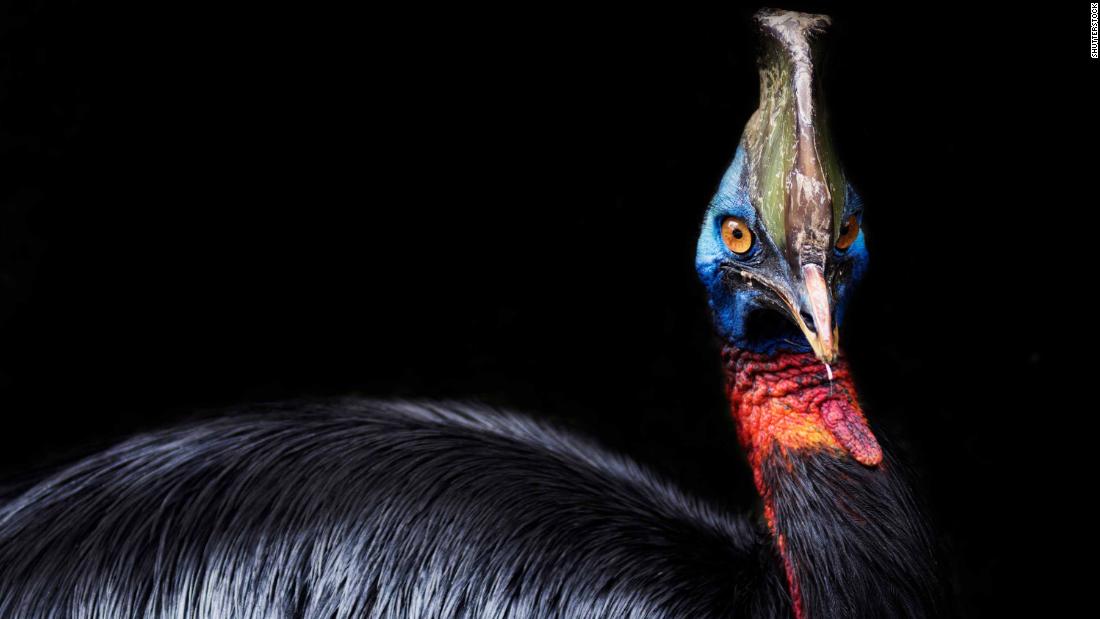
[ad_1]
Territorial, aggressive, and often compared to a dinosaur in appearance, the bird is a surprising candidate for domestication.
However, a new study of more than 1,000 fossilized eggshell fragments, unearthed in two rock shelters used by hunter-gatherers in New Guinea, has suggested that early humans may have collected the eggs of the great flightless bird before hatching, then reared chicks to adulthood. New Guinea is a large island north of Australia. The eastern half of the island is Papua New Guinea, while the western half is part of Indonesia.
“This behavior that we are observing happens thousands of years before the domestication of the chicken,” said lead author of the study Kristina Douglass, Assistant Professor of Anthropology and African Studies at Penn State University.
“And it’s not a small fowl, it’s a huge, mean, flightless bird that can gut you,” she said in a statement.
Today, the cassowary is the largest vertebrate in New Guinea, and its feathers and bones are valuable materials for making body ornaments and ceremonial clothing. Bird meat is considered a delicacy in New Guinea.
There are three species of cassowary and they are native to parts of northern Queensland, Australia and New Guinea. Douglass thought that our ancient ancestors probably raised the smallest species, the dwarf cassowary, which weighs about 20 kilograms (44 pounds).
The fossilized eggshells were carbon dated as part of the study and their age ranged from 18,000 to 6,000 years.
Not for snacking
To reach their conclusions, the researchers first studied the eggshells of live birds, including turkeys, emus and ostriches.
The interior of eggshells changes as developing chicks get calcium from the eggshell. Using high-resolution 3D images and inspecting the inside of the eggs, the researchers were able to build a model of how the eggs looked during the different stages of incubation.
Scientists tested their model on modern emu and ostrich eggs before applying it to fossilized eggshell fragments found in New Guinea. The team found that most of the eggshells found at the sites were all near maturity.
“What we found is that a large majority of the eggshells were harvested at advanced stages,” said Douglass. “Eggshells look very late; the pattern is not random.”
Those late-stage eggshells report that people living at these two rock shelter sites collected eggs when cassowary embryos had fully formed limbs, beaks, claws and feathers, according to the study.
But did humans deliberately collect these eggs to allow them to hatch, or did they collect the eggs to eat them? It’s possible they’ll do both, Douglass said.
“We also considered burning the eggshells,” Douglass said in the press release. “There are enough samples of late-stage eggshells that don’t show burns that we can tell they’re hatching and not eating them.”
The big bird as a precious resource
Less mature eggshells showed more signs of scorching, suggesting that when cassowary eggs were eaten, they were cooked and eaten when their contents were mostly liquid.
“In the highlands today, people are raising cassowary chicks to adulthood, in order to collect feathers and eat or sell the birds. It is possible that cassowaries were also highly regarded in the past, as they are among the largest vertebrate animals in New Guinea. chick cassowaries would provide a readily available source of feathers and meat for an animal that is otherwise difficult to hunt in the wild as an adult, ”she explained via email.
However, there is still a lot that researchers don’t know.
To successfully hatch and rear cassowary chicks, people should know where the nests are, know when the eggs were laid, and remove them from the nest just before they hatch. This is no small feat as the birds do not nest at the same sites every year. Once a female lays the eggs, the male birds take over the nest and do not leave for 50 days while the eggs are incubating.
“People may have chased the male and then collected the eggs. Because the males do not leave the nest unattended, they do not feed much during the incubation period, which makes them more vulnerable to predators,” she declared.
The research was published Monday in the peer-reviewed scientific journal PNAS.
[ad_2]
Source link